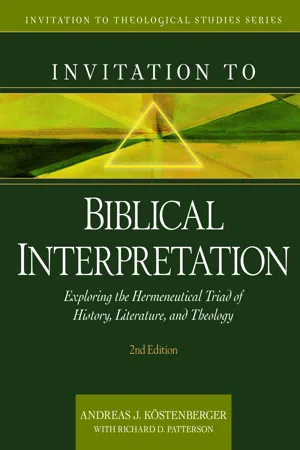
eBook - ePub
Invitation to Biblical Interpretation
Exploring the Hermeneutical Triad of History, Literature, and Theology
- 704 pages
- English
- ePUB (mobile friendly)
- Available on iOS & Android
eBook - ePub
Invitation to Biblical Interpretation
Exploring the Hermeneutical Triad of History, Literature, and Theology
About this book
An authoritative guide to accurately interpreting and applying God's Word
In this second edition of Invitation to Biblical Interpretation, Andreas Kostenberger leads the reader step-by-step through the process of interpreting and applying God's Word.
The primary principle is the hermeneutical triad, which consists of history, literature, and theology. Readers are equipped to explore the historical background of a biblical passage, analyze its literary genre and features, and derive its theological meaning in light of the biblical canon. Numerous examples are provided throughout to illustrate the concepts. A concluding chapter provides direction on practical application, preaching, and helpful tools for Bible study.
Additional features include key words and definitions at the end of each chapter, study questions, and practical exercises for applying the material. An appendix lists numerous resources for Bible study, including recommended commentaries for every book of the Bible.
The second edition updates these resources, as well as the sources cited throughout, and includes a revised chapter on the Old Testament canon. Instructors, students, pastors, and anyone who desires to interpret Scripture accurately will find this volume to be an indispensable addition to their library.
In this second edition of Invitation to Biblical Interpretation, Andreas Kostenberger leads the reader step-by-step through the process of interpreting and applying God's Word.
The primary principle is the hermeneutical triad, which consists of history, literature, and theology. Readers are equipped to explore the historical background of a biblical passage, analyze its literary genre and features, and derive its theological meaning in light of the biblical canon. Numerous examples are provided throughout to illustrate the concepts. A concluding chapter provides direction on practical application, preaching, and helpful tools for Bible study.
Additional features include key words and definitions at the end of each chapter, study questions, and practical exercises for applying the material. An appendix lists numerous resources for Bible study, including recommended commentaries for every book of the Bible.
The second edition updates these resources, as well as the sources cited throughout, and includes a revised chapter on the Old Testament canon. Instructors, students, pastors, and anyone who desires to interpret Scripture accurately will find this volume to be an indispensable addition to their library.
Frequently asked questions
Yes, you can cancel anytime from the Subscription tab in your account settings on the Perlego website. Your subscription will stay active until the end of your current billing period. Learn how to cancel your subscription.
No, books cannot be downloaded as external files, such as PDFs, for use outside of Perlego. However, you can download books within the Perlego app for offline reading on mobile or tablet. Learn more here.
Perlego offers two plans: Essential and Complete
- Essential is ideal for learners and professionals who enjoy exploring a wide range of subjects. Access the Essential Library with 800,000+ trusted titles and best-sellers across business, personal growth, and the humanities. Includes unlimited reading time and Standard Read Aloud voice.
- Complete: Perfect for advanced learners and researchers needing full, unrestricted access. Unlock 1.4M+ books across hundreds of subjects, including academic and specialized titles. The Complete Plan also includes advanced features like Premium Read Aloud and Research Assistant.
We are an online textbook subscription service, where you can get access to an entire online library for less than the price of a single book per month. With over 1 million books across 1000+ topics, we’ve got you covered! Learn more here.
Look out for the read-aloud symbol on your next book to see if you can listen to it. The read-aloud tool reads text aloud for you, highlighting the text as it is being read. You can pause it, speed it up and slow it down. Learn more here.
Yes! You can use the Perlego app on both iOS or Android devices to read anytime, anywhere — even offline. Perfect for commutes or when you’re on the go.
Please note we cannot support devices running on iOS 13 and Android 7 or earlier. Learn more about using the app.
Please note we cannot support devices running on iOS 13 and Android 7 or earlier. Learn more about using the app.
Yes, you can access Invitation to Biblical Interpretation by Andreas Köstenberger,Richard D. Patterson in PDF and/or ePUB format, as well as other popular books in Theology & Religion & Biblical Commentary. We have over one million books available in our catalogue for you to explore.
Information
PART 1
THE CONTEXT OF SCRIPTURE: HISTORY

CHAPTER 2 OBJECTIVES
- To impress upon the student the crucial importance of understanding the historical-cultural background of a given biblical passage.
- To assure the student of the trustworthiness of the biblical record.
- To direct the student’s attention to the need for determining the author’s purpose regarding the specific details he has chosen to record.
- To provide a set of interpretive guidelines for applying the principles embedded in the historical-cultural data of the Bible to contemporary social and political problems.
CHAPTER 2 OUTLINE
A. Introduction: History and Hermeneutics
B. Chronology
1. Old Testament Period
a. Primeval Period
b. Patriarchal Period
c. From the Exodus to the United Monarchy
d. Divided Monarchy
e. Exile and Return
f. The Writing Prophets
2. Second Temple Period
a. Babylonian and Persian Periods
b. Hellenistic Period
c. Maccabean Period
d. Roman Period
3. New Testament Period
a. Jesus
b. Early Church and Paul
c. Rest of the New Testament
C. Historical-Cultural Background
1. Primary Sources
a. Ancient Near Eastern Literature
b. Old and New Testament Apocrypha
c. Old Testament Pseudepigrapha
d. Dead Sea Scrolls
e. Other Relevant Primary Sources
2. Secondary Sources
D. Archaeology
1. Old Testament
2. New Testament
E. Conclusion
F. Sample Exegesis: Luke 2:1–20
G. Guidelines for Interpreting Biblical Historical-Cultural Backgrounds
H. Key Words
I. Study Questions
J. Assignments
K. Chapter Bibliography

Chapter 2
SETTING THE STAGE: HISTORICAL-CULTURAL BACKGROUND
INTRODUCTION: HISTORY AND HERMENEUTICS
IN ORDER FOR THE INTERPRETATION of Scripture to be properly grounded, it is vital to explore the historical setting of a scriptural passage, including any cultural background features. An informed knowledge of the historical and cultural background is imperative also for applying the message of Scripture. J. Scott Duvall and J. Daniel Hays put the issue well:
Since we live in a very different context, we must recapture God’s original intended meaning as reflected in the text and framed by the ancient historical-cultural context. Once we understand the meaning of the text in its original context, we can apply it to our lives in ways that will be just as relevant.1
Emphasizing the importance of historical information, of course, does not mean that every available piece of background data will necessarily be germane for the interpretation of a given biblical passage. The relevance of a particular piece of background information must to be carefully weighed and assessed. Certainly, background information should never override what is stated explicitly in the text. In fact, lack of judiciousness in selecting background information has led some to disparage the use of historical-cultural data in scriptural interpretation altogether (surely an overreaction).
For our present purposes, the most important hermeneutical question relates to the relationship between history and literature, the first and second element in the hermeneutical triad. Literature, in the ancient Greek and Hebrew languages, immediately reinforces the notion of texts, different from our own, with unique historical and cultural development. These texts not only require translation into an understandable language (English) but also the study of historical-cultural aspects embedded within them since both the biblical languages and other parts of biblical culture and history are inextricably intertwined.
Indeed, it is commonly acknowledged that it is vital to study Scripture in its proper context, and that context, in turn, properly conceived, consists of both historical and literary facets; so there is no need to justify the necessity of responsible historical research as part of the interpretive process. Suffice it to say that the necessity of historical research underlies major reference works such as study Bibles, Old and New Testament introductions, commentaries, and other standard reference works.
However, historical research has been given a bad name by the practitioners of the historical-critical method, which has been largely undergirded by an anti-supernatural bias that has consistently cast aspersions on the historicity of much of the biblical material.2 In reaction to the excesses of the historical-critical method, some have advocated a strict literary reading of Scripture while leaving aside the question of historical referentiality.3 While surmounting the difficulty of alleged historical discrepancies, this proposed method, too, is not without its problems, because it unduly severs the vital (in fact, inevitable) connection between the biblical texts and their historical-cultural embeddedness.4
What is more, postmoderns believe that impartial, objective history-writing is impossible. The view of history as events “as they actually happened” has given way to the realization that all historiography is of necessity subjective. In addition, postmodern critiques frequently lodge the charge that much of history is written by those who prevailed in the struggle for power and authority. Thus history-writing is often viewed as a tool of oppression wielded by the powerful against the disenfranchised. In this context, all historiography, including the biblical records, are viewed with suspicion, and widespread skepticism rules the day.5
Despite the views of postmoderns, history is here to stay.6 After all, Christianity is a historical religion, at whose heart is a historical event, the resurrection of Jesus Christ (see esp. Paul’s comments in 1 Corinthians 15). Unless Jesus rose from the dead historically, we are not saved but remain in our sin (1 Cor. 15:16–19). In a memorable interchange in the pages of the Trinity Journal, Carl F. H. Henry and Hans Frei debated this very question, and Frei, who espoused a focus on the text to the detriment of history in interpretation, found it difficult to affirm unequivocally that Jesus rose from the dead not merely textually, but historically.7
This shows how important it is not to unduly divide the historical and literary dimensions of Scripture but to keep them in proper balance, as is integral to the hermeneutical triad used in the present volume. The very fact that the triad consists of history, literature, and theology shows the need for historical research to be balanced by a proper focus on the text (literature) and sufficient attention being given to theology (that is, God’s self-revelation in the sacred, historically embedded text). Conversely, Bible students should avoid both the excesses of the historical-critical method and the reductionism of unmitigated literary approaches that set themselves over against historical research.8
CHRONOLOGY
Reading the Bible reveals the great distance in time between the events recorded in Scripture and today; in its pages ar...
Table of contents
- Cover
- Title Page
- Copyright
- Dedication
- Contents
- Preface
- A Personal Note to Teachers, Students, and Readers
- Complete Outline
- Abbreviations
- Preparation: The Who, Why, and How of Interpretation
- Interpretation: The Hermeneutical Triad
- PART 1—The Context of Scripture: History
- PART 2—The Focus of Scripture: Literature
- PART 3—The Goal: Theology
- Application and Proclamation: God’s Word Coming to Life
- Glossary